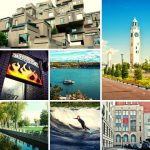
Montreal stand-up comedy is a thriving scene, which is not surprising given the cosmopolitan nature of the city. The reality is that the history of Montreal is just as diverse as the many types of comedy you can see here. For those visiting or those who may have forgotten some things from their history books, here is an overview of the history of Montreal.
History of Montreal: Early Inhabitants and Founding
The area that would become Montreal has a history spanning over 8,000 years since the initial First Nations tribe settled the area. It was the Iroquois people that are the first known residents of the area. People speaking the Iroquois language had a surprisingly large range. Spanning the areas surrounding much of the Great Lakes including Quebec, southern Ontario, New York, and Pennsylvania. Specifically, Montreal was initially inhabited by the St. Lawrence Iroquois.
The first European to set foot in what would later come here was Jacques Cartier. In 1535, on his second expedition to New France, he was welcomed by the Iroquois First Nations at a fortified Iroquois village called Hochelaga. The village was made of 50 longhouses. Cartier was attempting to find a sea route to China but was stopped by the rough rapids west of the island. He named them La Chine, thinking China was just past them, a name that remains with the Lachine Rapids today. Cartier claimed the land for France, naming it Mont-Royal. After the initial European colonists arrived, many of the Iroquois remained residents in the area.
Montreal was officially founded as a city in 1642 by Paul de Chomedey de Maisonneuve. He named the area Ville-Marie in honour of the Virgin Mary. The initial town included a fort, chapel, stores, and homes. You can find the Point-a-Calliere museum at this location today. The name Ville-Marie would eventually be replaced by Montreal, as the name of the island would be used to refer to the city.
Times of Conflict
Montreal became the site of tension and conflict. The Iroquois sought to maintain their home and fought back against the European settlers who were attempting to take the land. After years of periodic battles, the settlers ultimately defeated the Iroquois, cementing their control of the area.
The 1750s saw the Seven Years War between France and Britain expand to the North American territories. Quebec became a major area of conflict in what became known as the French and Indian War. Ultimately, British forces of over 4,500 launched a surprise attack on the French in Quebec City. The battle lasted just 18 to 25 minutes with more than 1,000 people dying including the military leaders of both sides. This battle to the north cemented British control over Quebec – and Montreal – for nearly a century.
By the time the city shifted to British control, it was a town of 5,000 people. It would be briefly captured by the Americans in 1775; however, they would be quickly fended off, leaving after only a few months.
A Time of Growth and Urbanization
The 1800s were a time that saw significant growth and urbanization. This was supported mainly by the opening of the Lachine Canal in 1825. This allowed ships to better navigate the area and spurred the advancement of the industry. The city was officially incorporated in 1832 and by 1850, the population was nearly 60,000.
Development in the first half of the 1800s included the founding of the Bank of Montreal, the Police Department, and access to gas lights. During this time, the city also suffered from battles with typhus and cholera epidemics. In 1852, Montreal found itself having to rebuild from a massive fire which left much of the city in ruin.
The thriving industry from the city’s port spurred incredibly rapid growth with the city expanding to half a million inhabitants by 1914. Consequently, by 1941, the figure had grown to 900,000 persons.
The Birth of Modern City
The middle of the 1930s saw Canada recover from the Great Depression. Soon, in Montreal, the changes were evident in the skyline as skyscrapers began to appear. These included the Sun Life Building, which served as the hiding place for the British Crown Jewels during World War II.
The latter half of the 1900s saw Montreal continue to grow. The city’s metro system opened in 1966 and it served as host to the International World Exposition the following year. In 1976, it hosted the summer Olympic Games, beating out Moscow for the honour. Venues included the now iconic Olympic Stadium.
This period of growth was largely presided over by Jean Drapeau, the long-standing mayor that made a huge impact on the city. Drapeau served in the position from 1954 to 1957 and then again from 1960 to 1986. This would give him a total of nearly three decades at the helm of the city. He was affectionally called “Mr. Mayor” by the residents.
Drapeau’s vision for Montreal to become a modern city with a high quality of life was exhibited by his efforts. In addition to hosting international events, he was also instrumental in Montreal being awarded the Expos Major League Baseball franchise in 1986. He is also known for his efforts to help the poor and the creation of many public parks and recreation spaces.
The City Today
In 2002, provincial legislation merged a number of suburbs into the city of Montreal as boroughs. This was not a popular move and led to a further reorganization in 2006 which established fifteen distinct municipal areas in addition to the city of Montreal.
Montreal saw many people immigrating to the city over the years, making it the multicultural center that it is today. Today, more than 120 cultural communities can be found amongst the city’s 1.8 million inhabitants. The greater metropolitan area is home to nearly 4.3 million people. The city is now the second-largest city in Canada.
Modern Montreal remains perhaps the most bilingual city in the world. This city is certainly one of the most welcoming in North America. Most resident speaks at least a bit of both French and English with the ability to switch from one language to the other when needed. This makes it a lovely and convenient place for visitors who are welcomed with wide arms by our city’s residents.
For those wanting to learn more about the history of Montreal, there are many excellent museums where you can learn more. These include Pointe-a-Calliere, Chateau Ramezay, and the McCord Museum. Of course, while visiting our city, we certainly welcome you to Comedyville for stand-up comedy.
Post by Eddie Case, exclusively for Comedyville.ca, All rights reserved.


 Previous Post
Previous Post Next Post
Next Post